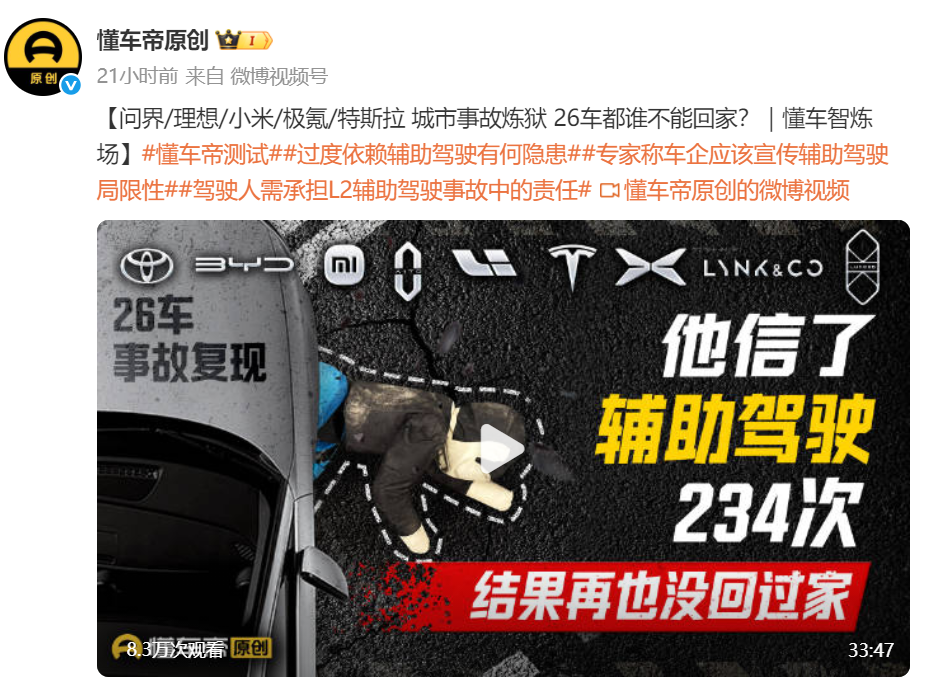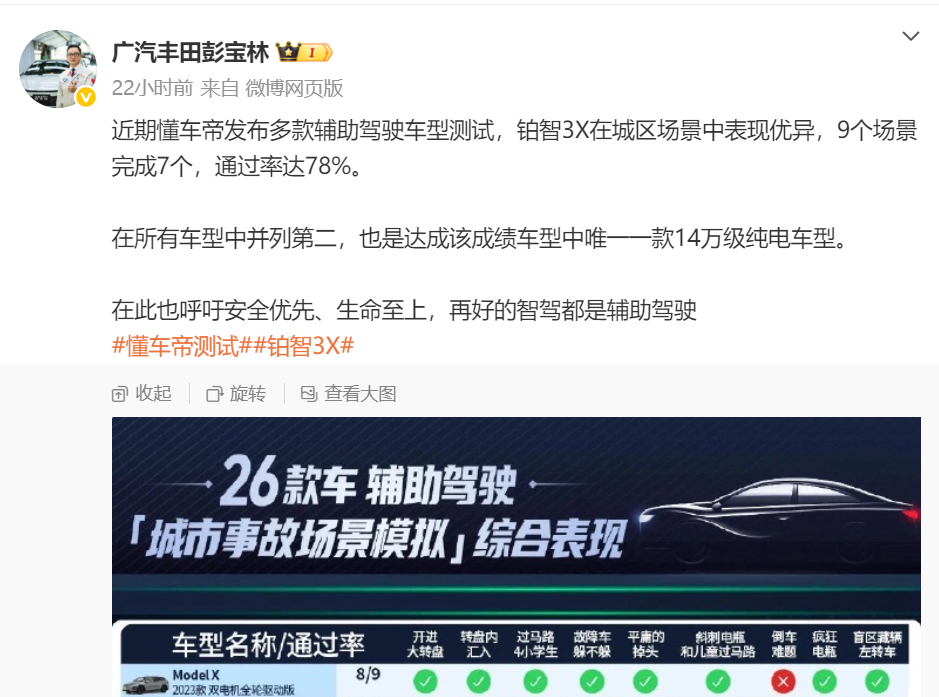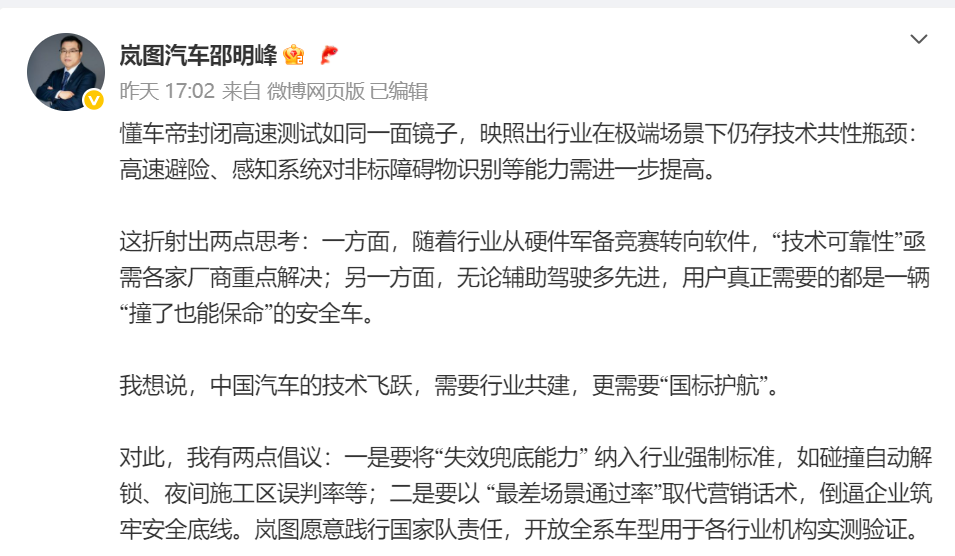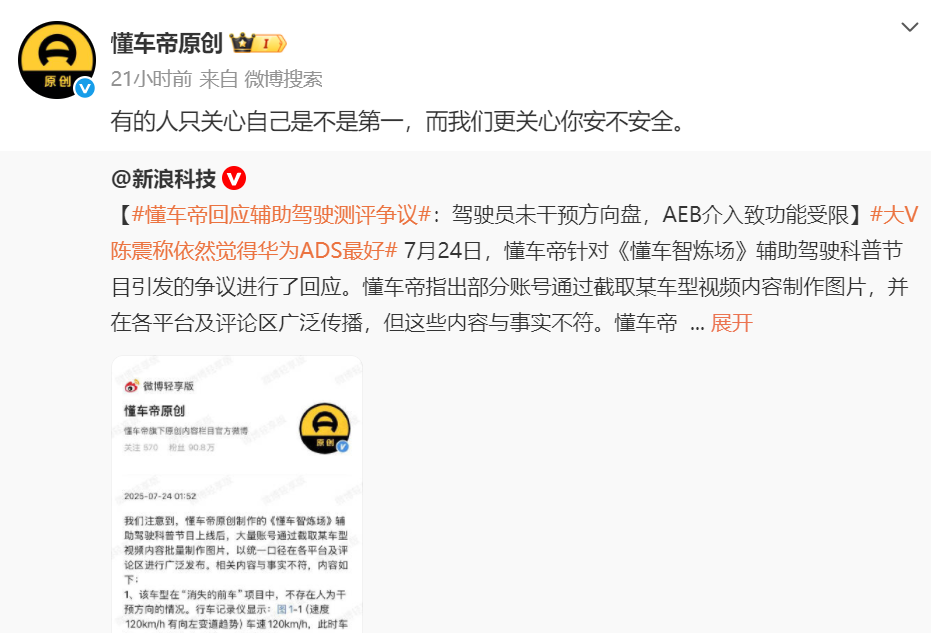This year, the boundaries of autonomous driving levels are becoming clearer, and the industry's attention to the safety of intelligent driving is increasing. Recently, on July 23, the State Council Information Office held a series of themed press conferences on 'high-quality completion of the 14th Five-Year Plan'. In response to questions about smart car technology, Wang Qiang, director of the Traffic Management Bureau of the Ministry of Public Security, stated that currently, the 'smart driving' systems installed in cars sold in the Chinese market do not possess 'autonomous driving' capabilities and remain at the level of driver assistance, requiring human control, with drivers being the ultimate responsible parties.
Recently, the automotive media platform Dongche Di conducted a driving assistance testing program called 'Dongche Zhilian Field', selecting nearly 40 models from over 20 popular brands, including AITO, Zhijie, Xiaomi, Xpeng, NIO, BYD, Li Auto, Avita, and Tesla. They simulated 15 real accident scenarios in urban and highway environments to educate the public about driver assistance features. The urban scenarios included 'entering a large roundabout', 'merging within a roundabout', 'primary school students crossing the road', and 'avoiding a broken-down vehicle', while the highway scenarios included 'accident vehicles appearing on the highway', 'encountering trucks during construction', and 'disappearing leading vehicles'.
The results from this testing quickly stirred controversy within the automotive industry. The overall pass rate for driver assistance features still shows significant room for improvement, with users advised against over-reliance. In urban scenarios, the pass rates for 'merging within a roundabout', 'primary school students crossing', and 'stopping for children at a crosswalk' exceeded 50%, at 77%, 58%, and 58% respectively; however, the pass rate for 'entering a large roundabout' was only 23%. The highway scenarios had even lower pass rates, with 'encountering trucks during construction' achieving the highest at 47%, while scenarios like 'disappearing leading vehicles' and 'a pig crossing recklessly' had pass rates of only 14% and 5% respectively.
Overall, domestic Chinese brands like the Zhijie R7, AITO M9, and Tengshi Z9GTEV performed excellently, with pass rates in both urban and highway scenarios exceeding 50%. In contrast, only Tesla's Model 3 and Model X stood out among joint ventures and foreign brands. Additionally, models like the Equation Leopard B5, Avita 07, and Avita 12 excelled in urban scenarios with pass rates around 70%, while Xpeng G6 and Weipai Lanshan were among the few that performed better in highway scenarios than urban ones.
This testing revealed the current deficiencies in intelligent driver assistance technology, prompting car manufacturers to recognize their technological shortcomings and increase R&D investments to improve algorithms and enhance the reliability and safety of their systems. For consumers, it also encourages a more rational view of intelligent driving features, avoiding over-reliance and enhancing safety awareness.
Regarding the test results, car manufacturers reacted differently. GAC Toyota's deputy general manager Peng Baolin noted that their model, the Platinum 3X, performed excellently in urban scenarios, completing 7 out of 9 with a 78% pass rate, placing it second among all tested models and being the only pure electric model priced around 140,000. He emphasized the importance of prioritizing safety and that even the best intelligent driving systems are still just driver assistance.
Homeland Intelligent Transportation's official account seemed to respond by stating they have seen the 'testing' from a certain platform but would not comment. Lantu Motors' CBO and sales general manager, Shao Mingfeng, remarked that the closed highway tests by Dongche Di reflect common technological bottlenecks in extreme scenarios, indicating areas for improvement such as highway evasion and the identification of non-standard obstacles.
Tesla showed particular interest in the Dongche Di testing. Elon Musk shared a video related to the program, stating that due to legal restrictions on data exports, Tesla achieved the highest results in China without local training data. Tesla's vice president Tao Lin stated that Musk had long proposed developing driver assistance that is ten times safer than human driving, and Tesla has now surpassed this goal in multiple quarters. They emphasized that while they observed the testing results through media, they do not focus on rankings as any test is relative and temporary, but the demand for safety is limitless. In response to the controversy sparked by the 'Dongche Zhilian Field', Dongche Di stated on July 24 that some individuals only care about whether they are first, while they care more about safety.
Dongche Di also clarified that certain accounts misrepresented video content of a specific model and spread it widely, but this content was not factual. They clarified that during the test, the driver did not manually intervene with the steering wheel to interrupt the vehicle's lane change; instead, it was the vehicle's AEB (Automatic Emergency Braking) that triggered and suppressed the NCA (Navigate on Autopilot) functionality due to AEB's ongoing involvement, preventing the vehicle from executing a detour.
From a broader perspective, this testing prompts the entire industry to re-evaluate the development path of intelligent driver assistance. As the trend of automotive intelligence deepens, intelligent driving assistance has become a crucial area of competition for car manufacturers. They need to increase investments in technology R&D, testing validation, and user education. In technology R&D, balancing hardware and software development while focusing on algorithm optimization is essential to improve the system's ability to recognize and respond to complex scenarios. In testing validation, manufacturers should learn from this testing experience to increase the diversity and authenticity of testing scenarios, ensuring the safety of intelligent driving assistance systems under various extreme conditions. In user education, it's vital to help consumers correctly understand the boundaries of intelligent driving functions to avoid safety incidents caused by over-reliance. Dongche Di's recent intelligent driving test is undoubtedly a deep reflection on the current development of intelligent driving assistance in the automotive industry, revealing both technological progress and shortcomings, as well as showcasing the different attitudes of car manufacturers in facing challenges. In the future, as technology continues to evolve, manufacturers persist in their efforts, and industry standards gradually improve, intelligent driving assistance is expected to genuinely become a capable assistant in ensuring driving safety and enhancing the driving experience, propelling the automotive industry into the era of intelligence. However, before that, both manufacturers and consumers need to remain rational and cautious.
China's Autonomous Driving Standards Becoming Clearer Amidst Safety Concerns

Images



Share this post on: